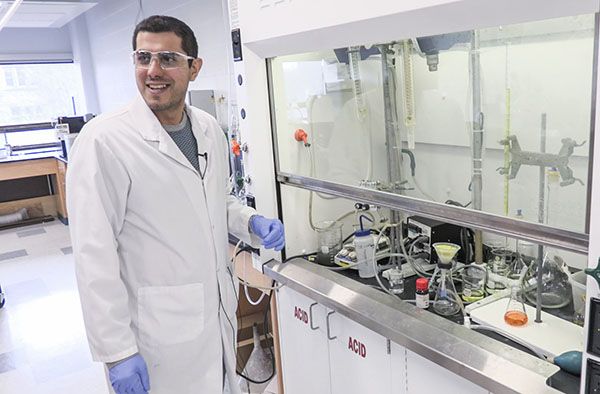Advanced mining technology provides a competitive edge for the Canadian mining industry. The Kostuik Mine-Mechanical and Offroad Robotics Laboratories provide both undergraduate and graduate students with exposure to state-of-the-art techniques and tools for the maintenance, design, mechanization, and automation of mining equipment and processes. Training is done through software-based design, analysis, and simulation tools, and through access to mid-scale industrial equipment. This allows students to study complex mechanisms at the machine level, while evaluating machine and process interactions at the systems level. The simulation software tools and techniques also enable the programming and evaluation of machine control and automation strategies. These laboratories are an integral part of the Mine-Mechanical Engineering program. This program is unique in North America in providing a blend of mining and mechanical engineering training. This prepares engineers for the increasingly equipment/technology-intensive mining industry. Undergraduates in the program use these laboratories for their final-year design projects, and for courses in machine automation and mine maintenance.
Queen's is the only university in Canada that has a well-equipped explosives test facility. The facility is located 50 km north of Kingston. It includes a bunker equipped with an ultra-high-speed streak and framing camera, digital oscilloscopes, a portable data acquisition system, VOD monitors, a Hycam high-speed camera and two Locam relatively high-speed cameras. There are also two blasting chambers to study dust explosions and gaseous products of detonation. On-campus equipment includes a gas chromatograph, digital image analysis systems for fragmentation analysis and numerical modelling tools for the analysis of explosives performance and sensitivity as well as the calculation of damage, fragmentation and throw in commercial blasting applications.
The instrumentation laboratory contains typical sensor technology (electrical, vibrating wire, optical, hydraulic, microseismic, etc.) used for the manufacturing of rock mechanics instrumentation. An extensive range of instruments available in the market are available for testing and calibration. These include extensometers, strain gauges, joint meters, stressmeters, strain cells, pressure cells, load cells, piezometers, etc. The application of data communication and data management techniques is also practised through a number of available data acquisition systems.
Research is primarily concerned with the application of new energy sources for the recovery and recycling of metals with the use of plasmas and microwaves in extractive metallurgy. Microwaves are a relatively new energy source with considerable potential and fundamental research is being performed on the interactions of microwaves with minerals in this laboratory. The lab is equipped with microwave ovens, temperature sensors, crucibles, etc. The technology is being studied for drying, heating, and smelting applications. One particular application with potential is the drying and smelting of lateritic ores where microwaves are being considered for use as an alternative energy source in the conventional segregation process for nickel.
The Mineral Processing Laboratory includes: sample preparation room, physical and chemical mineral concentration, ferrous and non-ferrous metals and precious metals extraction, wet chemical and instrumental chemical analysis, and gold fire assay. The sample preparation room is equipped with jaw, gyratory, and rolls crushers, full range standard screen, Sweco and Gibbson screens, Disc and Bico pulverizers, and rotationary sample splitter. The physical and chemical concentration labs include spiral concentrator, shaking table, Knelson concentrator, low intensity and high intensity magnetic separators, dry and wet high gradient separator, Capco high tension separator, Denver and Wemco flotation cells, column flotation cell, centrifugal flotation cell and micro-flotation cell.
The metals extraction laboratory includes column leach, bottle roll leach, ambient and high temperature leach, Parr autoclave, roasting and induction furnace, carbon adsorption and desorption, resin ion exchanger, electrowinning, and metals refinery.
The assay laboratory includes wet chemical analysis, atomic absorption spectrophotometer, X-ray analyzer, LECO sulphur and carbon analyzer, laser particle analyzer, infrared spectrophotometer and gold fire assay.

There are three computer labs available to all students, with one main teaching lab and two workrooms. Each space has computers with all the programs students need to complete assignments- from Microsoft Office to sophisticated design software such as Surpac, Whittle, and Talpac.

Alongside the usual equipment for physical property testing (such as apparent bulk density, point load strength testing and Brazilian indirect tensile strength determination), the rock mechanics laboratory has two compression loading frames, including 880 kN and 4000 kN closed loop, electro-hydraulic stiff-testing machines and a 35 MPa capacity lateral pressure triaxial cell; direct shear testing equipment; laboratory sample preparation equipment including diamond saws for cutting rock blocks and cores, high capacity diamond drill and diamond lathing apparatus; and microseismic monitoring systems for acoustic emission and seismic wave velocity determination. All equipment is available for teaching, research, and commercial service applications.
A large computer lab provides our undergraduate students with access to industry-standard software used in underground mine design. This includes Surpac, and all of the Rocscience software including Dips, RS2, Examine2D, Examine3D, RocData and RocSupport. The same software is available to our graduate students, as well as more advanced geomechanics software packages for research and teaching such as FLAC, FLAC3D, UDEC, 3DEC, and PFC.
The laboratory offers the ability to introduce principles and experimental techniques in occupational health and mine ventilation. Principles and techniques involved in dust concentration measurements are introduced and the concentration of mine gases is precisely determined with specialized instrumentation. Noise exposure is determined with sound level meters. The laboratory is equipped with standard instruments used for ventilation surveys including barometers, manometers, anemometers, pitot tubes and psychrometers. A ventilation analogue is used to simulate mine ventilation network systems and to introduce a number of control problems associated with regulation, leakage and boosting ventilation in mines. A simulator is used to evaluate pressure losses in mine roadways and the effects of wall roughness, obstructions, bends and changes in cross-section on airway resistance. An airflow system fitted with a centrifugal fan is used to introduce flow, pressure, resistance, and shock loss measurement techniques. Two automated ventilation systems permit computer-controlled testing, simulation and characterization of centrifugal and axial flow fans. A wind tunnel is also available to permit instrumentation calibrations and flow simulations.